The AMD Kabini Review: A4-5000 APU Tested
by Jarred Walton on May 23, 2013 12:00 AM ESTKabini Gaming and Battery Life
We've covered the general performance and some synthetic graphics tests. What about actual games? Well, here’s what our (admittedly punishing) 2013 gaming suite looks like on Kabini. These are the "Value" results, as the "Mainstream" and "Enthusiast" settings are unplayable on anything without a dGPU (though those results are available in Mobile Bench if you're interested).

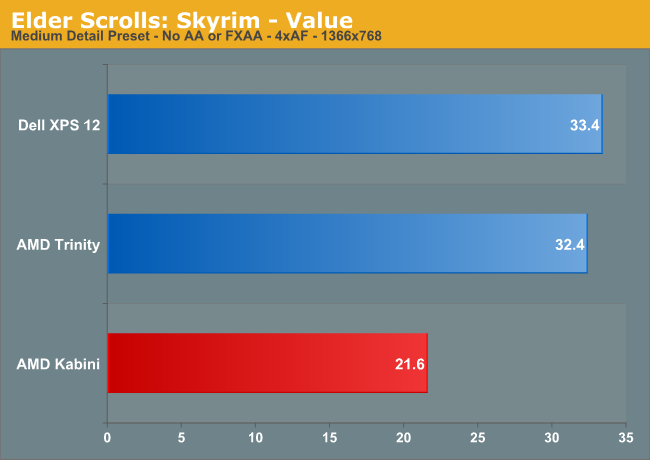
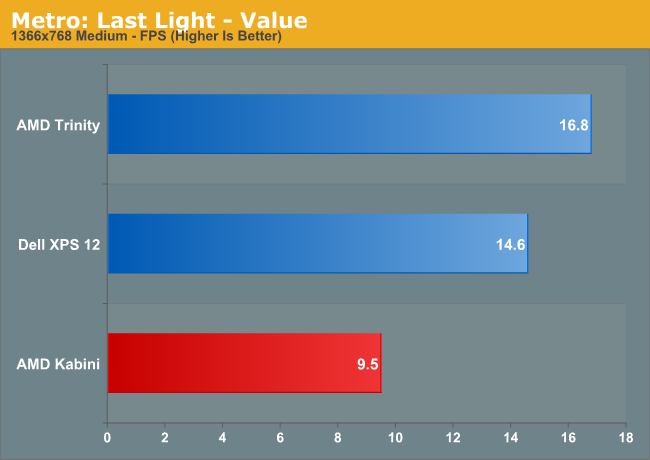
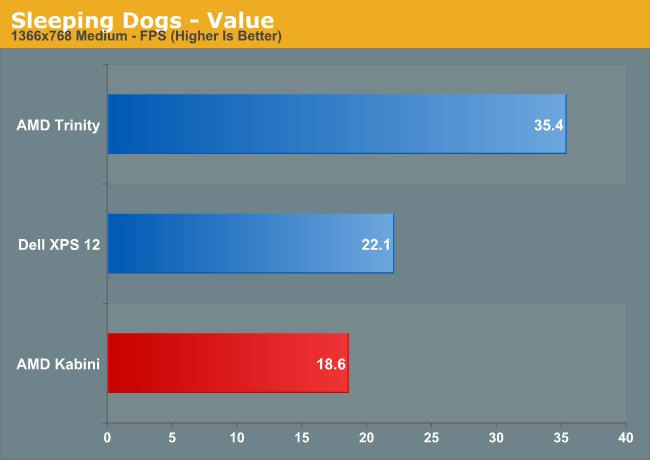
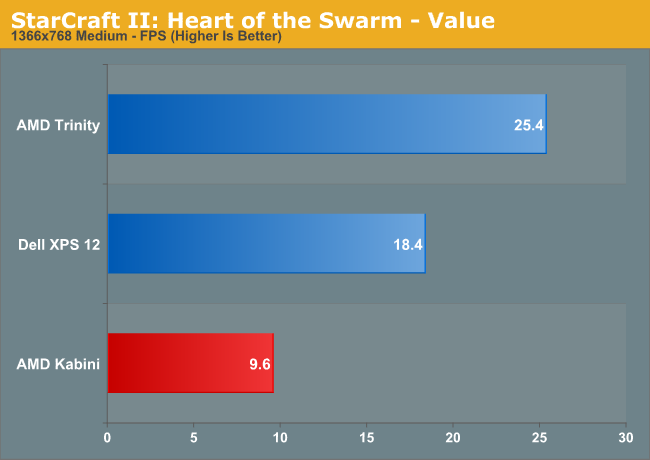
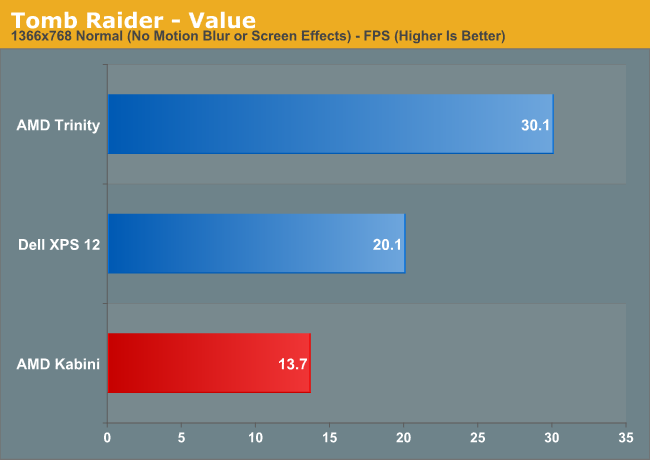
The short summary is that not a single game manages to crest the 30FPS mark, and I even ran additional tests at the minimum quality settings (at 1366x768) to see if I could improve the results. Sadly, I couldn’t, at least not enough to make the games playable; the best I managed was around 25 FPS in Bioshock, Skyrim, and Tomb Raider at minimum detail, and most titles remained in the sub-20 FPS range. Titles that tend to be more taxing on the CPU side of things like StarCraft II are even worse, with frame rates in StarCraft II being half of what IVB ULV gets at our Value (medium quality minus antialiasing) preset.
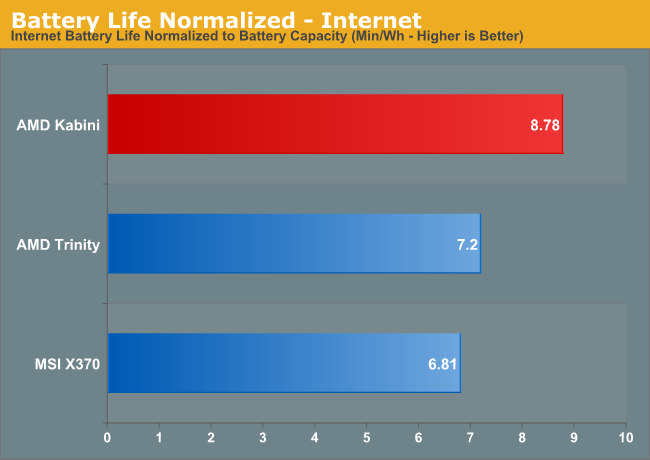

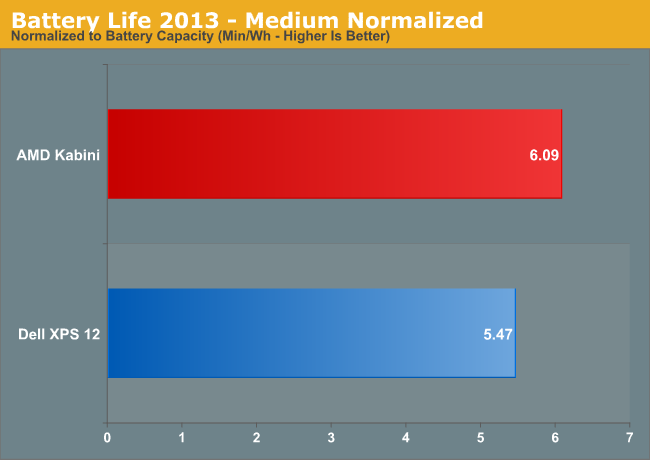
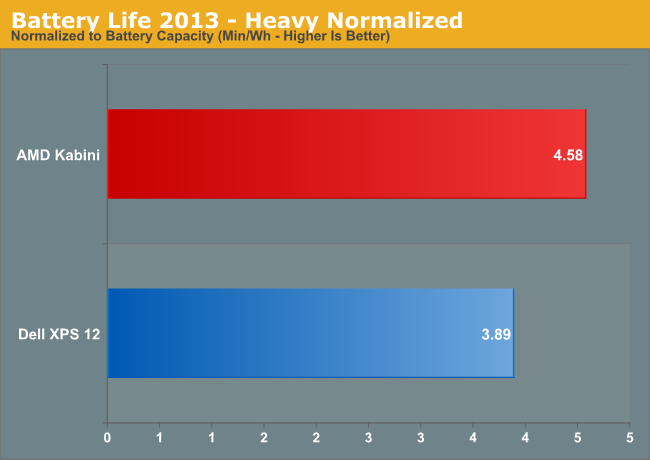
The good news is that not only is Kabini noticeably faster than Brazos, but it’s also mighty frugal when it comes to power use. We don’t have any Brazos laptops handy, so we had to use our older Internet battery life test as a comparison point (100 nits instead of 200 nits); in that test, Kabini topped 6.5 hours with a 45Wh battery. The MSI X370 we’re using as a comparison point did last a bit longer, but it also has a 64Wh battery. In terms of normalized power use, the Kabini laptop ends up being 29% more efficient, and that’s with a 14” AHVA 1080p panel going up against a 13.3” TN 768p display. We’re not quite able to compare apples to apples, but Kabini definitely looks like a good improvement over Brazos in power use.
The power story is even better when we look at ULV Ivy Bridge and standard Trinity APUs. Using our new battery life tests, which push the hardware a lot harder than our previous tests, Kabini delivers normalized battery life that’s at least equal to IVB ULV (our “Light” test), and in the more taxing Medium and Heavy tests Kabini beats ULV by 11% and 18%, respectively. Of course the IVB ULV system is still faster, and it’s also likely to cost twice what we expect Kabini laptops to sell for, but lower cost Celeron and Pentium ULV parts shouldn't be all that different. Also of note is that we don’t know yet how Haswell will fare in these same tests, but that’s an area Intel seems to be focusing on for their next CPU; that’s a story for next month….










130 Comments
View All Comments
Musafir_86 - Thursday, May 23, 2013 - link
-Finally!-BTW, some pictures still missing/not loading...
-Thanks for the article, but when Anand's architectural deep-dive will come out?
Regards.
Musafir_86 - Thursday, May 23, 2013 - link
-Sorry, I missed the link on the main page, and all pictures load correctly now.Thanks.
codedivine - Thursday, May 23, 2013 - link
Kabini looks interesting. Somewhat surprised that the max bandwidth (10.5 GB/s) supported is less than even Exynos 5 Dual (12.8GB/s).Wondering whether the GPU supports fp64 and at what rate?
codedivine - Thursday, May 23, 2013 - link
I guess Anand answered the fp64 question in the other article already :)axien86 - Thursday, May 23, 2013 - link
Wow...the AMD Jaguar Temash and Kabinis cost about the same as Atoms (~$30-$50) and perform many times faster than Atoms.
I wonder why Anandtech did not compare the Kabinis against Atoms/Celerons instead of i3 and i5 that cost around $200 to $225+ ?
JarredWalton - Thursday, May 23, 2013 - link
Sadly (not really -- Atoms are trash), we don't have any recent Atom/Celeron/Pentium laptops around. No one has ever sent us a Celeron or Pentium laptop for review, and the last Atom netbook we tested was probably almost two years back. Anand does have Clover Trail covered, but there's no real point in running our heavy laptop suite on that.JDG1980 - Thursday, May 23, 2013 - link
In the mini-ITX DIY segment, Kabini may compete against the Celeron 847 boards (which currently run about $75). I'd be interested to see how it stacks up there. The AMD solution would have a clock speed advantage (847 only runs at 1.1 GHz) but the Sandy Bridge-based 847 almost certainly has better IPC.MrMilli - Thursday, May 23, 2013 - link
Here you go: http://www.computerbase.de/artikel/prozessoren/201...BushLin - Friday, June 21, 2013 - link
Thanks for that, my German isn't great but from what I can tell this chip is a great choice compared to Intel's actual competing products. Such a shame Anand's review is with a Pentium consuming over twice the power and i5/i7 products costing many times more.My interest is in the low power desktop boards and hope to see a useful comparison on here at some point. I'm sure Zotac or some other manufacturer with such a leaning would be happy to supply comparable boards to cover Kabini and the lower power Pentium and Celerons.
jagd - Thursday, May 23, 2013 - link
Dual channel may not help to CPu but you are forgetting GPu , this is a shame for anandtech .